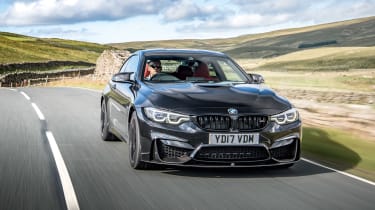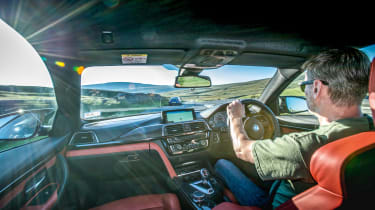BMW M4 (F82, 2014-2020) – ride and handling
The F82 is lighter than the E92 it replaced, and as a result is more alert and agile – at the expense of some feel
BMW worked very hard to keep the weight of the M4 as low as possible – the prop shaft, for instance, is carbonfibre, as is the roof panel and bootlid. The resulting kerb weight of 1537kg (when equipped with the DCT) is some achievement, particularly when you consider that the contemporary Lexus RC F weighed in at 1765kg.
The result is that the M4 feels alert, agile and responsive. There is so much grip across the front axle that it seems nigh-on impossible to get the thing to understeer – that gives the car enormous cross country pace. The steering is electrically-assisted rather than hydraulic, as is the way in the industry these days. The consequence is that some of the detailed feel that previous M-car coupes possessed has been lost, but this new system is at least crisp and very precise.
In dynamic terms, this is a complicated car. On dry, relatively flat roads it really is no less than superb, with agility, grip and on-throttle adjustability to spare. With the stability control knocked into its intermediate M Dynamic Mode (MDM) you can enjoy the car’s finely-balanced and exploitable chassis without throwing away the safety net altogether. Naturally, with the systems fully off it will execute the most impressive oversteer slides, but not before you have grown accustomed to the aggressive torque delivery.
More reviews
Which brings us on to the first of the M4’s weaknesses. That massive and immediate torque surge can upset the rear axle very suddenly, particularly in wet or greasy conditions. The car is traction limited in all but the driest conditions and that makes extracting all of its performance on a winding road something of a wild ride.
The chassis also lacks body control when the road begins to crest and undulate. Rather than giving the impression of being locked into the road surface, the car instead goes light at the rear axle and gives the impression of trying to break away. Again, this can make the car a real handful to drive quickly.
Even once you are keyed into the M4’s quirks, abandoning all of the driving aids is a huge leap of faith if you really want to make progress rather than showboat. The halfway-house that is the MDM mode might sometimes feel a bit restrictive but allows you to drive uninhibited, free from the fear that a sudden spike in torque or a severe bump will fire you off the road. You can then relish in the chassis’ balance; brake late into a corner and feel the rear axle become excitable as it unloads and guides the car into the apex. Get on the power just at this point and you can steer the M4 through the corner with the throttle. Keep it neat and you don’t even feel the MDM nibble away at the brakes to keep you in line and slow you down.
Although the standard cast iron brakes are more than up to the job, the M carbon ceramic brakes are even better on circuit – keen trackday drivers should seriously consider these.
Changes for the Competition Package did quite a bit to improve the standard car's dynamics. Increased spring rate and 20-inch wheels mean the car rides more firmly, but never becomes intolerable. The payback however is that the rear of the car is much better controlled over crests and undulations. The car now copes much better with sequences of bends and humps, but is still just as agile. The CS, meanwhile, went a step further with lightweight parts and standard-fit Cup 2 tyres, and drove with the kind of clarity and precision you’d expect from a finely-honed M car.
The M4 GTS is an entirely different proposition to other M4s. Firstly, the rear seats are replaced with a roll cage, the fronts with Recaro bucket seats, the bonnet is carbonfibre, the exhaust is titanium and the brakes are carbon ceramics. All this contributes to a weight saving of 30kg over an ordinary M4 fitted with a DCT gearbox. Not a huge amount, but then you must consider the water tank in the back and the plumbing needed for the engine’s water injection.
There are other hardcore elements, too. At the rear is an adjustable wing, while at the front is a splitter with 60mm of adjustment. These additions create up to 28kg of downforce at the front and 93kg at the rear at 186mph.
Then there are KW coilovers all round. Ride height is adjustable and so is high- and low-speed compression damping, and rebound settings. BMW offers a recommended road and track setting, but you’re free to tailor the car’s balance and handling traits to your own tastes.
The GTS is loud. Tyre noise is prominent and the titanium exhaust sends vibrations throughout the entire car, but the hollering straight-six noise that comes out the back overwhelms everything. Unlike the synthetic noise from the standard car the GTS has a real hearty tone to it.
Traction in the wet is an issue in the GTS. More power and more boost than a standard M4, combined with some track-focused tyres, means that your progress is hobbled by the traction control. The engine’s spiky and aggressive delivery doesn’t fill you with the confidence to turn the systems off, either.
But when the weather is good the GTS’s chassis and steering really draws you in. There’s no denying the KW suspension is stiff but it eradicates any slack in the GTS; the body remains flat, taut and resolutely follows the road. The car’s complete loyalty to every single input means that you have absolute certainty in the steering and brakes. After time you build up the confidence to explore the throttle with the same conviction and, once the tyres are warm, you can begin to feel the huge amount of lateral grip the car can generate. Its vast amount of torque means that there’s still throttle adjustability at almost any speed and you can then use all the controls to manipulate the GTS to do exactly what you want.
At the opposite end of the scale is the M4 Convertible. Unsurprisingly, it's the least rewarding of the F-series M4s, weighing a portly 1825kg and suffering from less urgent performance and lazier handling. It's not bad for a drop-top, though, and still has the kind of rear-drive adjustability you'd expect from an M car.




